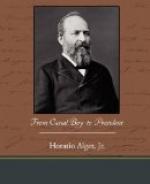Gen. Marshall fortified a strong natural position near Paintville, and overran the whole Piedmont region. This region contained few slaves—but one in twenty-five of the whole population. It was inhabited by a brave rural population, more closely resembling their Northern than their Southern neighbors. Among these people Marshall sent stump orators to fire them with enthusiasm for the Confederate cause. Such men would make valuable soldiers and must be won over if possible.
So all that portion of the State was in a ferment. It looked as if it would be lost to the Union. Marshall was daily increasing the number of his forces, preparing either to intercept Buell, and prevent his advance into Tennessee, or, cutting off his communications, with the assistance of Beauregard, to crush him between them.
To Colonel Garfield, an inexperienced civilian, who had only studied military tactics by the aid of wooden blocks, and who had never been under fire, it was proposed to meet Marshall, a trained soldier, to check his advance, and drive him from the State. This would have been formidable enough if he had been provided with an equal number of soldiers; but this was far from being the case. He had but twenty-five hundred men to aid him in his difficult work, and of these eleven hundred, under Colonel Craven, were a hundred miles away, at Paris, Kentucky, and this hundred miles was no level plain, but a rough, mountainous country, infested with guerrillas and occupied by a disloyal people.
Of course, the first thing to be done was to connect with Colonel Craven, but, considering the distance and the nature of the country to be traversed, it was a most difficult problem. The chances were that Gen. Marshall, with his vastly superior force, would attack the two bodies of soldiers separately, and crush them before a union could be effected.
Gen. Buell explained how matters stood to the young colonel of volunteers, and ended thus:
“That is what you have to do, Colonel Garfield—drive Marshall from Kentucky, and you see how much depends on your action. Now go to your quarters, think of it overnight, and come here in the morning and tell me how you will do it.”
In college Garfield had been called upon to solve many difficult problems in the higher mathematics, but it is doubtful whether he ever encountered a more knotty problem than this one.
He and Colonel Craven represented two little boys of feeble strength, unable to combine their efforts, who were called upon to oppose and capture a big boy of twice their size, who knew a good deal more about fighting than they did.
No wonder the young colonel felt perplexed. But he did not give up. It was not his way. He resolved to consider whether anything could be done, and what.
My chief object in writing this volume being to commend its subject as an example for boys, I think it right to call attention to this trait which he possessed in a conspicuous degree. Brought face to face with difficulty—with what might almost be called the impossible, he did not say, “Oh, I can’t do it. It is impossible.” He went home to devise a plan.




